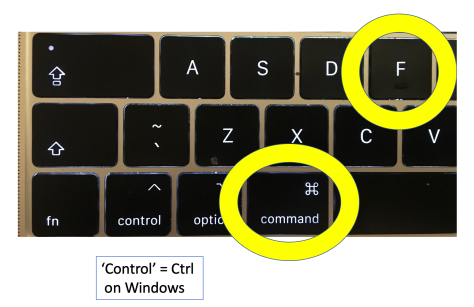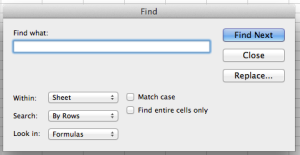International Ctrl+F Day – 18th August
I would like to propose the first annual International Ctrl+F Day on 18th August 2022, which is the 11th anniversary of the publication of Alexis Madrigal’s “Crazy: 90 Percent of People Don’t Know How to Use CTRL+F” article in The Atlantic which honestly blew my mind. The idea of people visually searching for a word or phrase on the web or in a Word document or PDF. What? Noooo!
The article arose from speaking with Dan Russell, a ‘search anthropologist’ at Google who’d sat with thousands of Google users, asking them to do tasks so he could learn how people use computers / internet / search engines. Dan found that 90 per cent of them scroll up and down in a document to find a phrase, rather than just ‘wormholing’ there with Ctrl+F, or Command+F on a Mac (you press the Ctrl or Command key first, then the letter F). The internet was quite diverted by this news.
How should we celebrate ICFD?
For those who wish to participate my suggestion would be to share a nice helpful mildly nerdy tip with friends, family or colleagues in a manner of your choosing.
Perhaps share the Ctrl+F article on Facebook, or share some useful snippet on the work intranet (perhaps “how to add your email address to the photocopiers” so that people can scan and email documents to themselves). Do members of your family regularly print articles from the internet? Do they know they can save a LOT of paper if they give themselves a little extra work to begin with by pasting the text into notepad or Word? Perhaps they might like that. Or have a glance at the list of posts on this blog for inspiration. Do tell people how to do Ctrl+F on a phone (for an iPhone it’s pull-down, start typing – I’m assuming something similar for other phone types).
While drafting this post I’ve used the following ‘nifty tricks’ which others might not know about (or you might have a better way of doing things, or know different tricks).
1. Every time I paste a quote in from the web I first paste it into notepad then copy and paste it from notepad into the post. This gets rid of formatting. I also do this when writing emails (paste it first into the subject line, then re-copy it and paste it into the email body). I hate having to reformat text so get that out of the way first. I always have a notepad file on the go for this sort of deformatting.
2. When pasting a quote I put the “” in place first, then paste the text inside the quotes. This means that if I’ve forgotten to de-format the text before pasting it there’s a character at the end already in the correct format. I really hate pressing Enter, starting to type and realising I’ve ‘inherited’ the previous unwanted formatting. Ugh 😉
3. While I didn’t use it in this instance I often use XXXX as a placemarker when I embed Tweets (or YouTube videos) so that I can open the editing window in HTML mode, use Ctrl+F to find XXXX and then replace it with the embed code by pasting it in. As it happens, on WordPress blogs you don’t need to use the embed code and can just paste in the tweet’s URL / link and it fwoomphs into its tweetly appearance. Of course I use Ctrl+C to copy text (or an URL) I’ve selected with the mouse (trackpad) and then Ctrl+V to paste it.
Let’s make the computing world marginally more navigable 🙂
I think it’s a nice thing to share your knowledge, particularly if it might make other people’s lives easier. Other things I’ve shared are about being careful when sharing a web link as it might include info about your address(1) and in general I clean up links of ‘cruft’ before sharing them, to keep things nice and tidy on the internet 🙂 I tidy up referrer links for example.
Background to this
I’d been using Ctrl+F for as long as I could remember(2) and I think I picked up the shortcut from spotting that Edit / Find menus had the shortcut listed next to it. Here’s what it looks like on a Mac.

It’s possible someone told me at some point in the 1990s, but I’m pretty sure I just noticed it, and consequently thought (not that I’d previously given it any thought) that everyone else had too, assuming (wrongly) that everyone else ‘saw’ what I saw. The article pointed out that it wasn’t just that people weren’t using keyboard shortcuts to quickly find something, they weren’t even using the Edit / Find menu to access this.
“I do these field studies and I can’t tell you how many hours I’ve sat in somebody’s house as they’ve read through a long document trying to find the result they’re looking for. At the end I’ll say to them, ‘Let me show one little trick here,’ and very often people will say, ‘I can’t believe I’ve been wasting my life!'” – Dan Russell
Alexis’ follow up post on 22 August 2011 “Why using Control+F may be the most important skill” pointed out that there had been 3 reactions to the first post:
“1) Whoa! That’s crazy! 2) No one knows keyboard shortcuts and it’s silly of you to expect that they do. 3) Wow, I did not know about this shortcut and it is awesome. All of which make sense in their own way.” – Alexis Madrigal
I often (often) find myself ‘just doing something’ on a computer, having done it for one or two decades without giving it much thought, then suddenly observing that I’m doing it and wondering if everyone does it). Each of us develops our own way of doing thing, as the article notes, “Browsing is an inherently private phenomenon and so tips and tricks are not so easily shared.”
This entire blog, and the #MildlyUsefulInfo hashtag on Twitter, are my response to that – sharing ways of doing things that I’ve picked up along the way, which others might not have. That’s not meant to sound arrogant, I’ve also picked up stuff from other people doing this – I hadn’t known that you could press and hold the spacebar on a smartphone ‘keyboard’ to control the cursor position, until someone shared that. Much better than ineffectively tapping at the end of a line hoping it would go there and invariably pressing some ‘X’ cancel button in error.
I’ve learned LOADS of things from Twitter pals and the internet more generally, including answers to questions I’ve asked (‘how do I..?’) and the ‘sudden surprises’ like the spacebar thing (which I’d never even have thought to ask about).
Footnotes
(1) I once entered my full home post code into a website to find out about local things and spotted something I wanted to share on Twitter. I was a bit surprised to spot that my post code had remained in the URL even after clicking on several things. It’s not a great idea to publish the last three alphanumerics of your post code as it narrows things down considerably, often to within several houses on your street. Similarly Deliveroo uses a geohash code which is a string of apparent gibberish but resolves precisely to your latitude and longitude. I had been about to share a link to a local restaurant and was glad to have spotted that first.
(2) I learned to touch type in 1988 so am very comfortable with a keyboard, I’ve been using PCs via command line (terminal) before Windows / Macs became widely available and I’m now familiar with both of those too. And smartphones.


